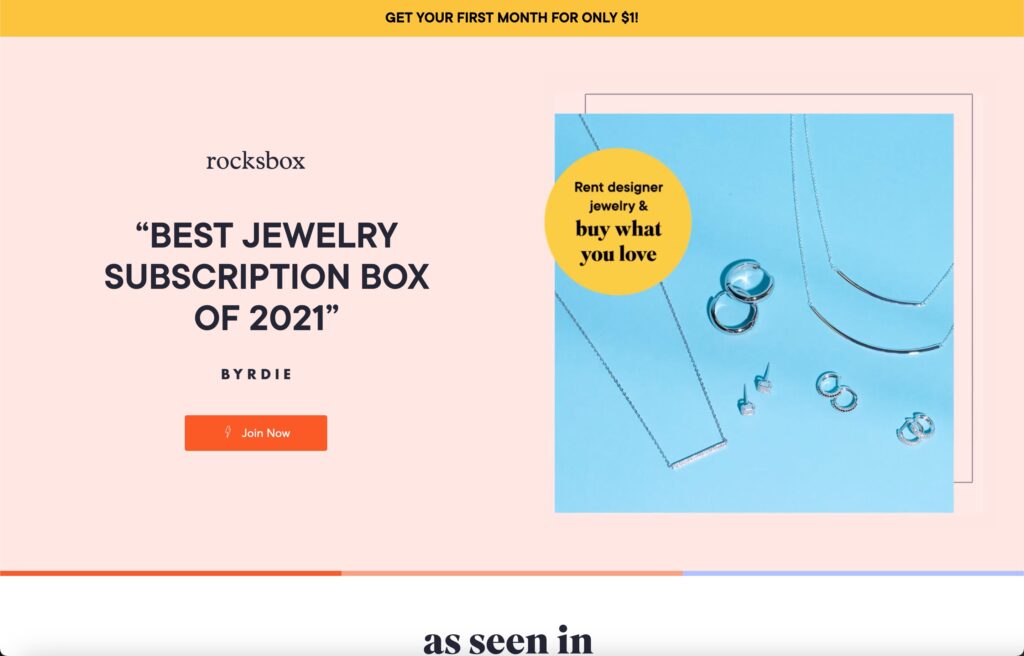Your landing page is the first intentional point of contact for your customers. Your ad templates led them to your landing page, and now it’s time to generate conversions and make a sale.
Is your landing page effective and provides your target audience with the best possible experience? The only way to know is to test it, but you can be more confident and avoid wasting time by ensuring you have the necessary elements of a winning landing page.
Elements of High-Conversion Landing Pages
The best landing pages focus on the customer’s journey and guide them toward conversion. In other words, consider what your audience needs, from scannable copy to custom-made visuals emphasizing your brand’s product or service, and make sure they can access it on whatever device they’re using.
Landing Page Templates
Keep your landing page template in mind. These variations address different things in their headers, and the remaining structure depends on the goal. For example:
- BDQs (Buyer Decision Questions) – Address the key questions your customer needs answered before they are confident buying. Include concise answers, stats and proof, and include unique selling points mixed in with your answers. I.e if you were buying a car, you would need to know the MPG, the # of doors and the paint color.
- Listicle – In a sequence, specify why your product will solve problems or what makes it unique. Using the listed examples as proof, promise to satisfy your future customers.
- Vs. Alternative – Position your product as the best possible solution to a customer’s problem, comparing directly to traditional solutions, your direct competitors, or doing nothing. You should provide meaningful comparisons vs alternatives, trustworthy testimonials, and a breakdown of why your product is the best solution.
- Sales Questions – Rather than you reminding them their problem or goal, ask a question that causes your target customer to recall their problem on their own. Continue asking Qs so that they remember how urgently they want to solve it, and how they’ll feel when they solve it. Once they’ve reminded themselves of what they want, they will be excited to follow through with your call to action (CTA) right away.
- Personalized – Simply state what makes your product different. Get the press talking about how great your product is, demonstrate how easy it is to get the product, share customer testimonials, add before and after pictures, and show what makes the product special.
- Press/Testimonial – Start with a quote validating your product’s selling points and show quotes from press outlets, customers, and UGC examples. Tell customers how easy it is to reach similar results and guarantee the product fits their needs.
Download Primer’s favorite landing page templates here!
Landing Page Key Elements
Run through this at-a-glance checklist to make sure your landing page has all of the essential elements that set it up for success.
- Most Crucial: Information that addresses your audience’s core Buyer Decisions Questions (BDQs)
- Differentiation from potential alternatives and competitors (position directly vs the alternatives)
- A focused and direct headline addressing your target audience according to your landing page template
- Clear calls to action (CTAs) both above the fold and in each section
- Easily scannable copy with no more than 3 lines per paragraph
- Responsive design — optimized for mobile and desktop use
- Uncluttered, consistent design elements throughout
Browse our landing page gallery to glimpse this checklist in action.
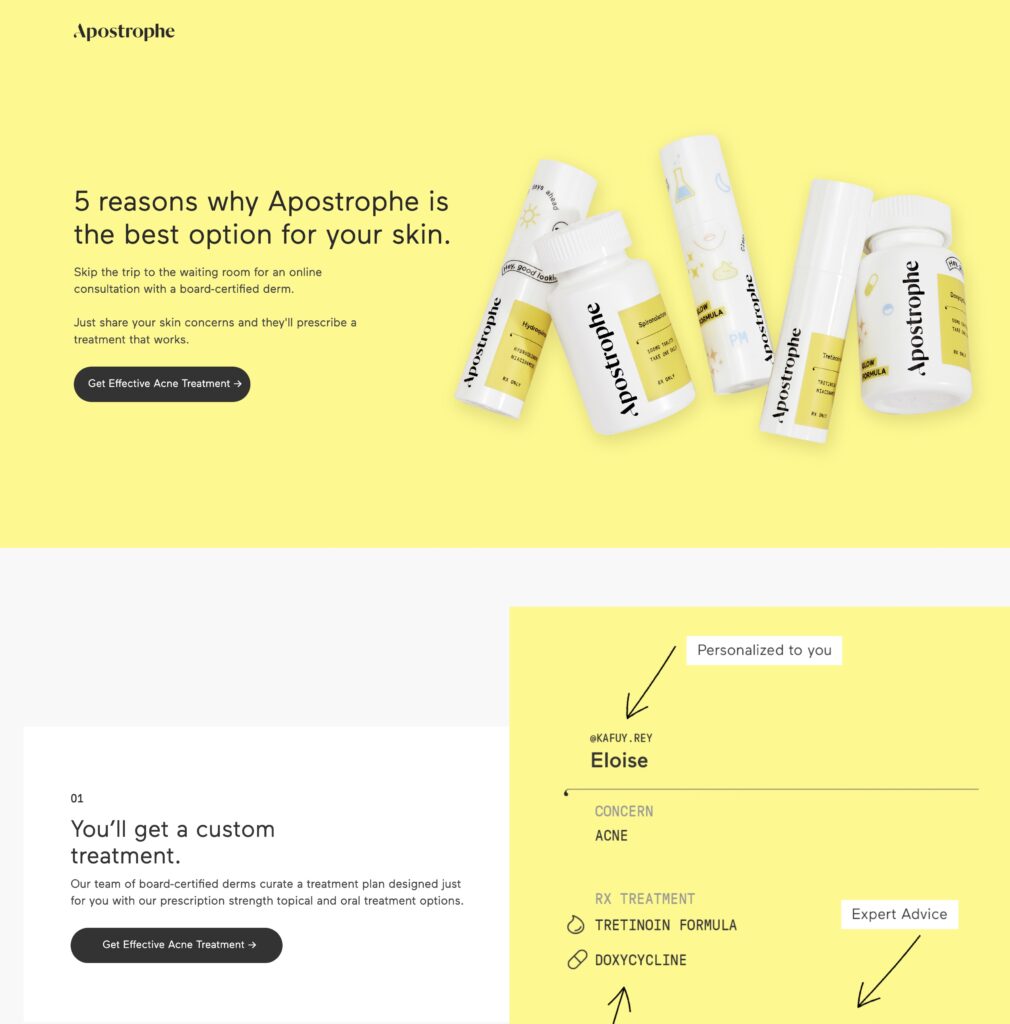
Strategizing Variety
Variations
Landing page wins fatigue much more slowly, so you get more bang for your investment in landing page creation. Once you find a win, you can easily scale that win by swapping the hero section headlines, body copy, images and videos (as well as within other sections) to improve results. This will give you a way to test a specific message or feature within the page without creating an entirely new page.
Test With Primer
Whether you’re looking for someone to deliver ready-to-launch landing pages designed to convert or you need a partner to develop and manage your landing page testing strategy, Primer can help.
You can access high-converting landing pages, images and videos with Primer On-Demand, Primer’s trusted online platform.
Interested in learning more about how Primer can help you create video ads and landing pages that convert? Schedule a free consultation today.
Did you know there’s a tried-and-true creative brief template for building deeper connections with your audience?
It’s called the founder’s story.
The founder’s story—as its name implies—is the story of the founder of a business or organization.
In essence, it’s the motivation, the why, behind the origins of the business as well as a guidepost for its core motivations.
A good founder’s story gives users the context behind the product or service they’re being told about. It’s a long-form story on the key problem that the business is trying to solve and its unique approach (the story itself) to address it.
At its core, the founder’s story is a personification of the business itself, humanizing it for audiences through the character of the founder(s) and giving readers a more intimate look into the heart of the business.
The founder’s story has been around since the dawn of marketing and advertising, from the storied pitches of traveling salesmen to the contemporary “about us” page of Fortune 500 companies.
And for good reason—it works.
Here, we’ll dive into the elements of the founder’s story, how it works, why it works, and how to use it—specifically as it applies to video ads and video storytelling.
Leverage Your Founder’s Story
At Primer, we have a playbook of several themes that have been proven to drive strong performance in engagement, conversion, and retention. Among those themes is the aforementioned “founder’s story.”
Within this theme, a unique story that drove the creation of a product or company is shared.
Here’s an example of a founder’s story from Nom Nom:
The story begins with a pair of mini Australian Shepherds named Harlee and Mim, and a handful of dog lovers in San Francisco.
In February 2013 what would become the founding family team of NomNomNow — now known as Nom Nom — went to casually look at puppies. Naturally, Alex, Zach & Natethe fell in love at first sight and adopted half-sisters Mim and Harlee.
Bringing home the girls now meant searching for dog food, and the team was surprised to see how little had changed in the dog food space since the 1980s: most dog food was still kibble or canned, filled with unpronounceable ingredients and industrial filler – the dog equivalent of microwaveable dinners.
Beginning in late 2014, the team began experimenting with cooking and delivering fresh food for friends and family. Cooking fresh took on added urgency as Harlee developed health issues related to a compromised immune system, and her vet recommended a fully fresh diet.
Enter Dr. Justin Shmalberg, a clinician and professor at a leading college of veterinary medicine and one of the world’s foremost experts on cutting-edge dog nutrition. Today our recipes are crafted to ensure our customers receive the best food for their dogs.
Within a few short paragraphs, Nom Nom gives readers a clear idea of who they are, how they came to be, and what their brand strives to offer to the public (the solution).
In this sense, the founders communicate the value of their company by positioning themselves as its first customers. They understand your needs because they’ve been on both sides.
These kinds of successful founder stories, ones pulled from helpful creative brief templates, serve as the backbone for building a connection with new audiences through video storytelling. Viewers want to have an emotional connection and respond to an emotional trigger/element; they want something to relate to and identify with on a human level).
Give them one, and they will respond to it.
Here are just a few examples:
Monti Kids
Trufora
Sunday
Each of these serves to drive the human element at the heart of their respective business and its message.
This particular theme works exceptionally well for video ads because video can combine a litany of audio and visual elements to tell a compelling story. In fact, many websites will leverage video assets on home pages, landing pages, and external social channels as core elements of their marketing/branding.
This Creative Brief Template Works for Expert Stories Too
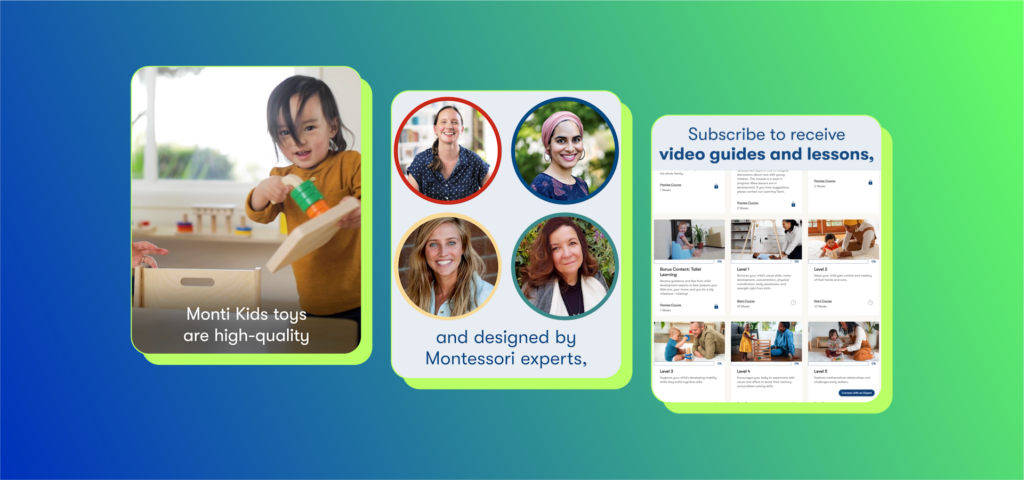
But what if you don’t have a compelling founding story?
Perhaps your founding story is more simple and straightforward: You identified a market, offered a new/unique product, and found success.
In those instances, you can still use the founder’s story creative brief template in the form of an expert’s testimony. Testimonials are exactly as they sound, they’re the positive testimony of an individual advocating the success of their experience with a product or service.
An extended review of sorts, a testimonial is a critical asset in marketing and advertising, giving readers the opportunity to connect with previous customers in place of the business or its founders.
A well-done testimonial is the story of an experience, one that can work to set the expectation for your brand, product, or service. Thankfully, testimonials don’t require the reader to know the person giving them. They instead serve as characters for your user to connect to via their story.
And similar to the founder’s stories, testimonials are deployed the same way via homepages, landing pages, and across social media channels.
The Power of Storytelling and Emotional Connection in Video Ads
When it comes to capturing an audience’s attention, there’s no better way in the modern, digital age than video. Take a quick look at the top social media platforms in the world, and their bread and butter is video-based content—largely short form.
From YouTube to TikTok, the ability to drive a marketing message through video storytelling has never been more in demand.
In fact, there’s a concept called “significant objects” in video storytelling that involves bonding the viewer to a specific object/product by giving it sentimental value.
For example, there was a shop that allowed writers to mock up stories for trinkets they were selling. These trinkets were then posted to eBay and were sold at a much higher value due to the built-in sentiment—the story—attached to these pieces.
Here’s one example:
As a child, I loved Beatrix Potter’s story of the two bad mice, Tom Thumb and Hunca Munca, who broke into the doll’s house where “the dinner had been bought ready-made, in a box full of shavings. There were two red lobsters, and a ham, a fish, a pudding, and some pears and oranges. They would not come off the plates, but they were extremely beautiful.” Tom and Hunca Munca smashed dinner when they found it could not be eaten; I keep the hot dog to remind myself that food does not have to be beautiful.
— Jenny Davidson
This case study showed that purchasing behavior is inherently linked to emotion, even when eBay marked the stories as fictional.
Users connect with these stories because they reflect the human side of companies. They show that experts at your organization change, grow, and face daily obstacles just like them.
If you can frame your story in those basic elements, you’ll be able to generate universal connections with your audience.
This is why the founder’s story theme and creative brief template work for video ads to drive conversions.
Improve Your Video Ads with This Creative Brief Template
Primer’s proven founder’s story template can be used to create winning video ads that will consistently and reliably drive conversions.
Here’s a quick look at the founder’s story formula:
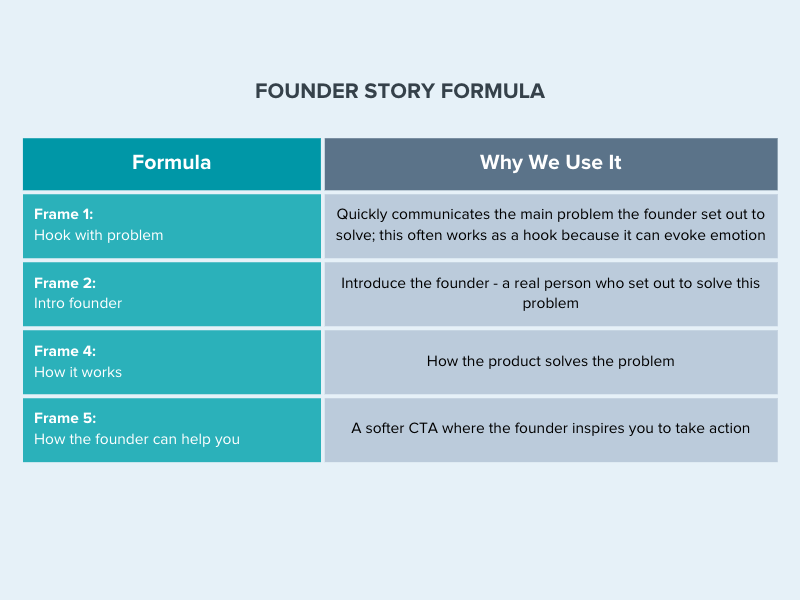
Each frame holds a crucial step in driving the story and fostering a stronger bond between your audience and your brand.
Check out this example from the fertility-based testing company, Proov. In the video, you can identify the step-by-step framework from the founder, Amy.
Video:
Template:

The founder’s story is a powerful tool, at times instantly connecting an audience to a business through a human medium—the founder or fellow customer (testimonial).
By following the framework of the founder’s story, it’s possible to create quick and lasting connections with new and returning customers. All you need to do is share a story that rings true within the minds and hearts of your viewers.
<<Click here to get our downloadable Founder’s Story Video Ad Creative Brief Template>>
Start Building High-Converting Video Ads Now
At Primer, we help our partners develop winning ads and scale by handling the process for you, including creative strategy, design, production, reporting, and media buying.
If you need high-quality ad creative with a rapid turnaround, our online platform Primer On-Demand gives you access to videos, images, and landing pages with a proven track record of driving conversions.
To learn how to create high-converting video ads, schedule a free consultation with Primer to find out how creative testing can help you script successful video ads.
The Power of Strategic UGC
Word-of-mouth motivates your customers 92% more than traditional advertising. They turn to social media feeds to find information from family and friends, discovering Instagram, Facebook and TikTok ads along the way.
Your customer’s goal is to discover authentic proof that your product or service will work for them, too. It’s up to you to tailor-make video ads that offer that experience to them, which is easier than you think.
UGC Myths
UGC in performance marketing is incredibly influential, but some brands still hesitate to jump on the UGC bandwagon. These are the most common reasons that marketers are afraid to leverage UGC:
- Finding a creator is too complicated
- The ads will appear sloppy or off-brand
- Coordinating with content creators is challenging and expensive
Fortunately, high-quality, affordable UGC is easier than ever to coordinate. This guide will walk you through everything you need to know to create high-converting UGC ads.
Simplify UGC from the Start
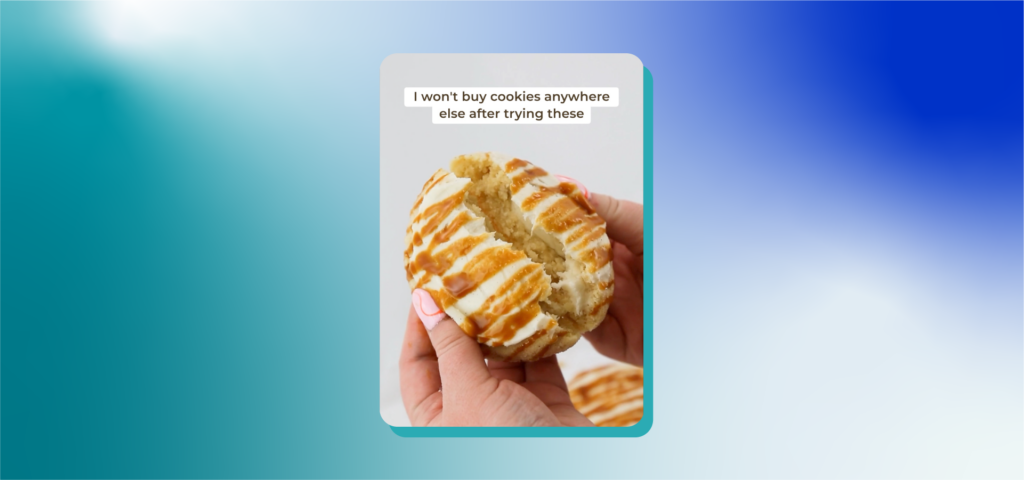
Explore the similarities between the buying patterns and shopping trends of your current and ideal customers and weave in the data you collected through marketing analysis and competitor research. Then roll it all together to create a fictional shopper or buyer persona that embodies all of these factors.
This customer—the “user” in your UGC—is who you’ve got to connect with. Tailor-make your UGC to appeal to them. Ask yourself,
- What do they want?
- What do they actively avoid?
- And what is your brand hoping to get from your UGC ad campaign?
Authenticity or Bust
UGC doesn’t work unless it’s authentic and natural. With new technology and social media platforms, brands can reach a seemingly endless pool of potential customers, all actively engaging with content. These potential consumers, however, didn’t sign into their accounts to become advertising targets. Instead, bombarded with ads, they developed an ad radar to detect overtly promotional or salesy content.
To avoid alienating their target audience, advertisers moved away from traditional ad campaigns on social media platforms towards UGC. But low-quality, spammy UGC sets off alarm bells every time.
59% of consumers say inauthentic advertising annoys them, which means if your brand sets off your customers’ BS alarm, you risk losing a potentially valuable customer.
Recommendations from trusted peers are more valuable. So, the organic UGC you’re creating reflects the relatable personality of your average buyer, making your marketing efforts far less likely to set off their ad radar.
Three Reasons Why You Haven’t Created UGC Ads—And What to Do About It
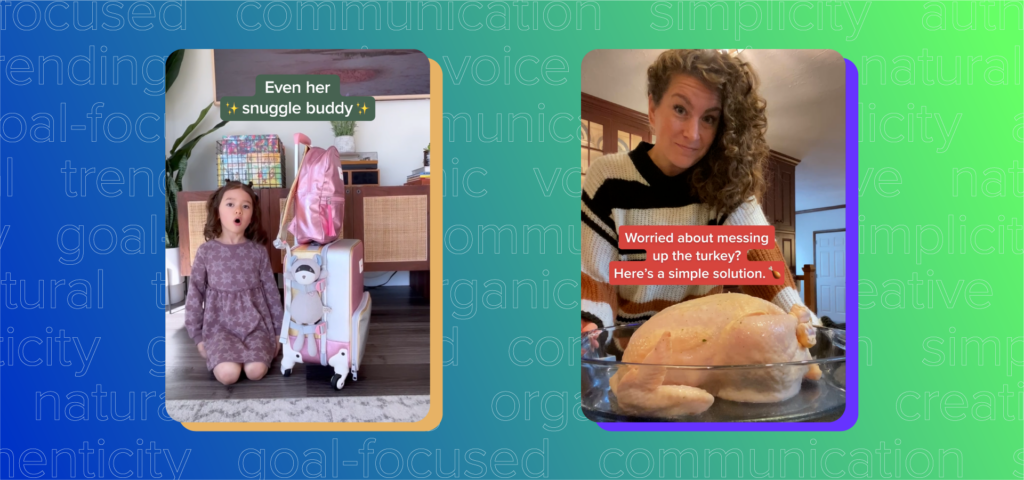
You’re Worried UGC Ads Will Feel Off-Brand
Here are some ways to inject your brand into your UGC TikTok ads:
Pick the right creator
Your content creator should embody your brand. Hire the real-life content creator version of your buyer persona. Having a content creator that is consistent with your brand helps blur the lines between paid and organic content.
Plus, working with a creator matching your brand’s target audience also provides fresh insights about your customer base and empowers you to create UGC ads that drive conversions.
All in all, your UGC gives your customers a glimpse into their future. If they can relate to your creator, they can envision themselves as your future customer.
Surround UGC with Branded Elements
Add an element of brand identity into UGC ads. Try layering text boxes and type treatments with your brand colors or fonts on top of the UGC footage. For more tips, see the next section.
Start Small
Not to over-emphasize, but finding the perfect content creator for your brand will help ease your mind. The quality of your UGC is far more significant than the quantity of UGC you post.
If you’re still feeling hesitant even after your brand-consistent creator makes your fresh UGC content—start small. Add UGC snippets into regular ads and track engagement and conversion data.
You’re Afraid Your UGC Will Look Sloppy
Follow these tips to achieve native-style UGC that still feels professional:
Pick Your Platform
UGC best practices differ by social media platform, so great TikTok ads might need a tuneup to perform well on Facebook.
Your social media followers are more likely to buy your product than brands they don’t follow, so studying each platform’s popular UGC can inspire you to create great content that blends in. For more ideas, check out how these popular DTC brands leverage different features across social media platforms.
Don’t Overdirect
Hiring the right content creator will virtually eliminate this concern altogether! They’re industry professionals. Rest easy knowing you’ll have high-quality footage for your team to edit.
Although UGC is supposed to be unpolished, good lighting is always appreciated. It’s worth mentioning to your creator that great lighting and clever product placement are important for your brand (many creators like to film during golden hour).
Provide a Shot List
You don’t want to get in the way of the creative process, but if there are specific shots, specific footage, or essential elements you want, including close-ups, demos, unboxings, etc., make a list for your content creator beforehand. Otherwise, let them run with it!
You’ve hired the right creator, so you’ll end up with professional footage.
You’re Concerned Your Ad Will Look Out of Place
Incorporate these native elements into your ads to achieve seamless UGC:
Use First-Person Perspective
Your audience wants to know how people like them use your product, and since your content creator fits your buyer persona, they’re the perfect person to share their experience directly.
A great way to create that connection is by using the first-person perspective. “I” statements are more relatable and help communicate authenticity—without being salesy. The “testimonial” and “how-to” formulas are great examples of first-person in UGC.
While it’s fine to mention, remember it comes naturally to most content creators, so don’t limit their creativity with a script. Your creator is the embodiment of your buyer persona. They’ll be able to relate and identify with their peers—your target audience—more authentically if they can speak freely (see next tip!).
Check out how the best TikTok ads are fun and creative without losing their organic feel.
Sound On
A video with sound improves the experience for your audience, whether they are Instagram Reels or TikTok ads. Trending songs, platform-specific sound bites, and voiceovers can add authenticity to your ads, but prioritize clear audio above all else.
Use Voiceover
Using voiceovers rather than trending music or audio clips engages your client and makes your UGC feel more relatable. You build trust by using narration to lead your audience through an experiential journey with your product as if they are close friends or are in on a secret.
Use This Formula for Winning UGC TikTok Ads
Take the guesswork out of your UGC ads by trying any of the fantastic ad templates available to brands and content creators.
Remember that effective UGC ads typically need the following:
- A great hook– It’s what compels people to stop scrolling and start listening. Ask your creator to film a few hooks—two is fantastic, and 3+ is even better!
- A motivator for finding solutions– Give the audience a moment to relate to the content before jumping into the fix.
- A way out (your brand!)– Introduce your brand’s product or service as the solution to their problem.
- An explanation of the benefits or features of your solution– Describe specific benefits and features.
- An authentic testimonial– Your creator’s voiceover or video (they can provide a few options).
- A CTA– Your audience wants to buy the product. Tell them how to do it!
Try this template:
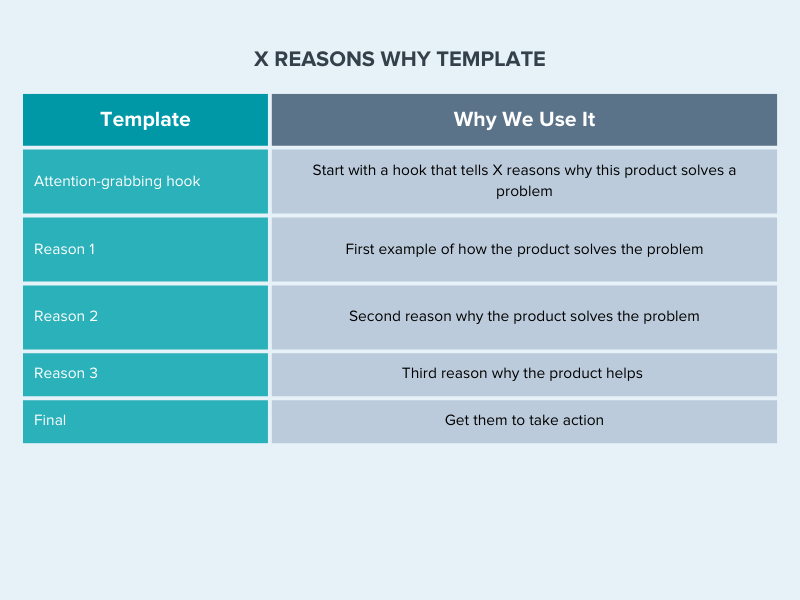
Example:
Leave It to the Pros
When your target customers become curious about how a product look in real life, whether they actually work as advertised, and if they are worth their money—they’re logging into their social media apps and looking for recommendations from content creators to find out.
By giving your customers access to this information, you can convert curiosity into purchases and see for yourself the significant ROI that UGC advertising brings.
Primer makes it easy. Discover new creators and get ready-to-launch UGC video ads with Primer. Schedule your consultation today.
Proov is a woman-founded startup that invented the first FDA-cleared at-home PdG (progesterone marker) test to confirm successful ovulation. Since developing this first test, Proov has expanded to a wide range of other at-home fertility tests.
Proov’s goal is to help women get more information about their hormones and cycles so they can get to their goals faster, and they wanted video ads to support that.
Because the PDG test is an innovative test that confirms ovulation rather than predicts it, Proov has to provide a significant amount of education for their audience in their ads and on their website. In particular, Proov focused on sharing how their PDG test differs from the standard ovulation test seen in the pharmacy.
Growth is the Name of the Game
As a venture-backed start-up company, Proov needed to maximize their growth. They saw the high conversion of video ads as the solution to getting information into the hands of women trying to conceive while achieving that growth.
Before working with Primer, Proov primarily focused on static ads created by their small, in-house marketing team to educate and empower women during their fertility journey. By 2022, they started making the transition to video ads, which are shown to drive 48% higher sales than their static equivalents.
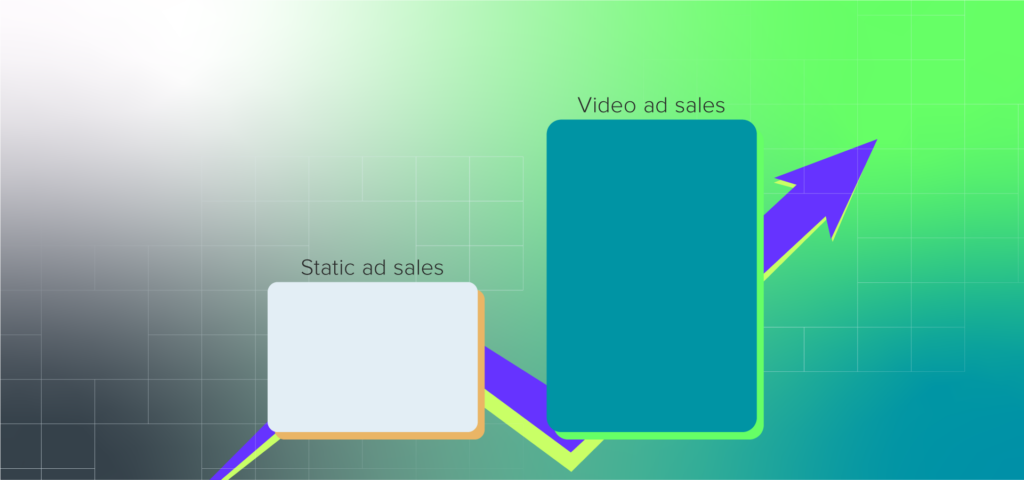
Like many performance marketers, they struggled to find the resources to create the video ads themselves for the following reasons:
- Their internal design team was small and did not have any video experience.
- They didn’t have prior knowledge to optimize and test video ads at the scale and speed they needed to achieve maximum growth.
- Their small in-house team couldn’t support the volume of creative needed for video ad testing.
Proov knew they needed a partner who could unlock their growth potential and fill a pipeline of stellar, informative creative for video ads and landing pages.
Enter Primer.
Partnering with Primer to Create and Test High-Converting Video Ads
Proov hired Primer in early 2022 to solve this problem of boosting their growth through video ads. Proov wanted to learn how to leverage video ads and landing pages to empower women and educate them about their cycle.
To help Proov build their strategy, Primer shared proven video ads, templates, hook ideas, and what works well with other brands.
Primer’s On Demand team worked as a resource to
- Provide proven concepts that they can easily build from to create high-converting video ads
- Share designs made by growth experts to ensure they are meeting all performance marketing best practices
- Deliver video ads and landing pages in as little as three business days so they can continuously test and find new wins
Using Proven Templates and Themes for Video Ads
Using these templates and examples, Proov was able to jump-start their work with Primer.
According to Maddie Barbera, Marketing Manager at Proov, “When we got off the ground, we had no knowledge of what was going to work and what kind of videos to make, so we thought we should test it all. We used a lot of Primer’s hooks and stacked our queue really long, which taught us a lot about what content works and what doesn’t.”
Proov infused education into their video ads and landing pages using the ideas shared by the Primer team to engage with their “information seeker” persona, women searching for information about their fertility journey. With their long queue of creative in the Primer On-Demand platform, Proov tested different ideas using these hooks and examples to understand what video content works best for their target customers.
Proov quickly learned that what you expect to perform might not always work.
“We had a lot of hypotheses about what content would perform well,” Barbera said, “but we were rarely right. We tried ads about ovarian reserve testing to go up against a competitor, but they totally tanked. Primer taught us a lot about how to educate people.”
After learning and testing, they found that the How It Works template resonated well with their audience and provided the education necessary to move toward a purchase decision.
Template:
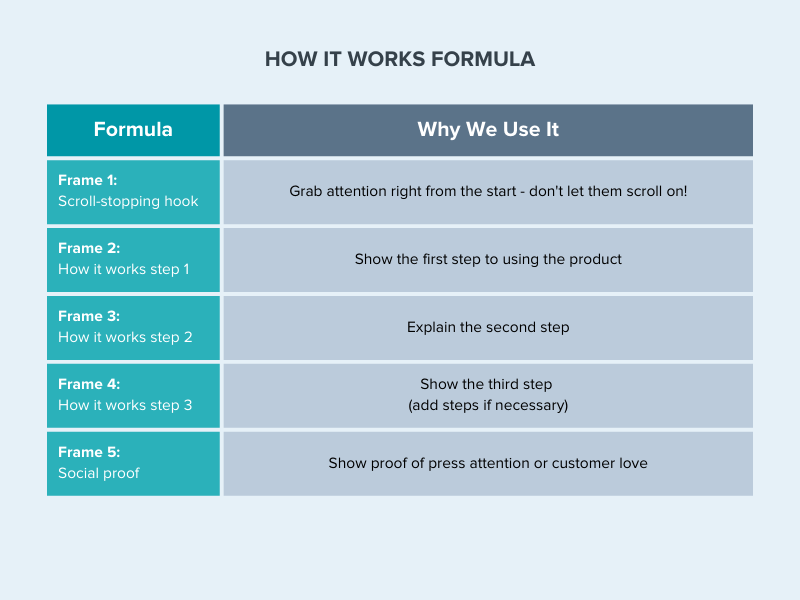
Example:
Leveraging Existing UGC Content
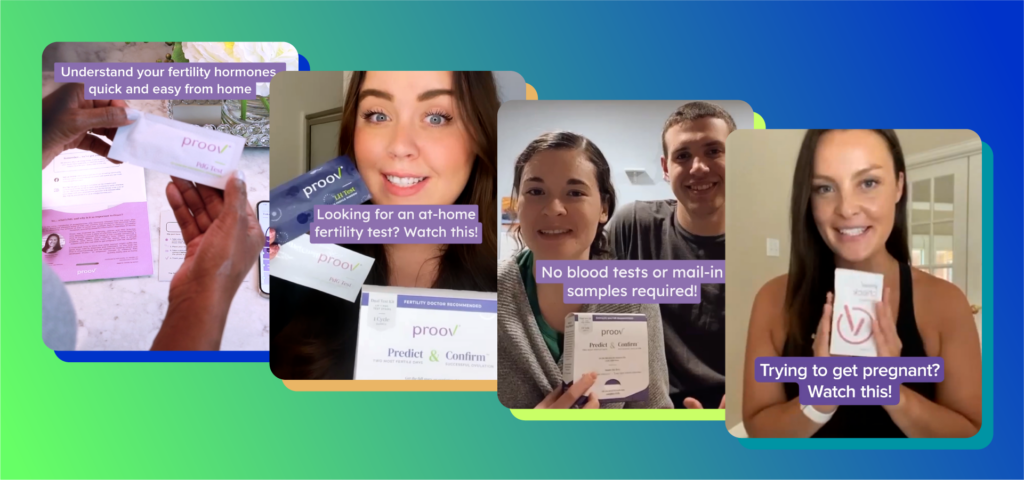
Along with learning about what works and what doesn’t, Primer also enabled Proov to leverage their cache of existing UGC content and video testimonials of women getting pregnant with the support of Proov products. Primer, Proov was able to capitalize on this UGC to create ad and landing page content quickly and easily.
The process was simple: Proov simply has to give Primer a script and the vibe of the ad, and Primer’s creative team can splice together UGC and other video content into high-conversion video ads and a partnering landing page.
This process of quickly generating content with Primer’s support allowed Proov’s in-house team to focus their energy on retargeting and structuring their ads according to their customer’s journey rather than spending time learning video and becoming growth-advertising experts.
For example, they found the following sequence resonated with their audience and moved them through the buyer’s journey:
Starting with a “how Proov works” style ad
Retargeting that same audience with video ads that focus on their founder’s story
Ending with a UGC-style ad helped their customers convert
This order of ads appealed to their “information seeker” persona because it started with education about the products, shared a deeply emotional story that gives the brand ethos, and ended with a real woman using Proov products during her journey to conceive.
Education-Focused Landing Pages
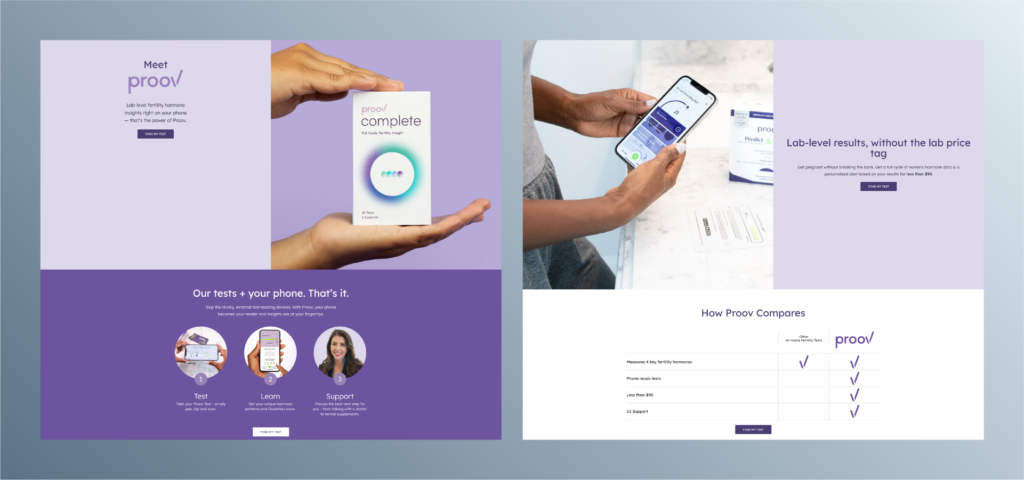
Before working with Primer, Proov knew that landing pages would be important, but they didn’t realize just how important they would be to their overall strategy.
Primer helped Proov reach women seeking information about infertility and at-home testing by strategically pairing ads with a landing page that digs deeper, delivers more information to that woman, and persuades her to try Proov at-home tests.
Proov grabs the reader’s attention on this landing page with the question, “Want to Get Pregnant?” coupled with a video showing how easy it is to test with Proov. Then they share a quiz to help women make an informed decision on the right testing product to purchase, a walkthrough of how easy testing can be with Proov products, and testimonials by real Proov users to provide layers of education to their audience.
The best part: Proov found that these landing pages were continuously reusable. After finding the ones that tested well, they updated packaging photos and other images as needed to keep the landing page fresh.
Results: Taking Ad Creative Production from 0 to 100
Before working with Primer, Proov relied solely on static ads produced by their internal resources.
By working with Primer On-Demand, Proov accelerated their video ad creation and now has 60 successful ads and 18 landing pages created by Primer that they can leverage to drive conversions.
According to the marketing team at Proov, working with Primer has “really taken landing page and video production from 0 to 100.”
Want to Partner with Primer?
Primer works to help our partners, like Proov, develop winning ads and scale by handling the process for you, including creative strategy, design, production, reporting, and media buying.
If you need high-quality ad creative with a rapid turnaround, our online platform Primer On-Demand gives you access to videos, images, and landing pages with a proven track record of driving conversions.
Schedule a free consultation with Primer to learn how creative testing can help you script successful video ads.
Let’s say you’ve crafted the perfect paid social ad using proven ad templates. The big question is, now that you have your audience’s attention, how do you get them to take the next step toward making a purchase?
The answer to that lies in your CTA, or call to action.
The most effective CTAs blend into the video or image around them. Yet this may leave you wondering how to write a less overt CTA that still captivates a viewer and converts them into a potential customer.
When it comes to creating video ads that will help maximize growth, we don’t believe you have to reinvent the wheel. Often, great marketing is about using what works and making it fit your brand’s messaging and voice.
Primer has tested thousands of video ads on social platforms like Facebook, TikTok, Instagram, and others, and we’ve learned how to develop a CTA that converts while also feeling organic to the user and native to the social platform.
Why Should You Include a CTA?
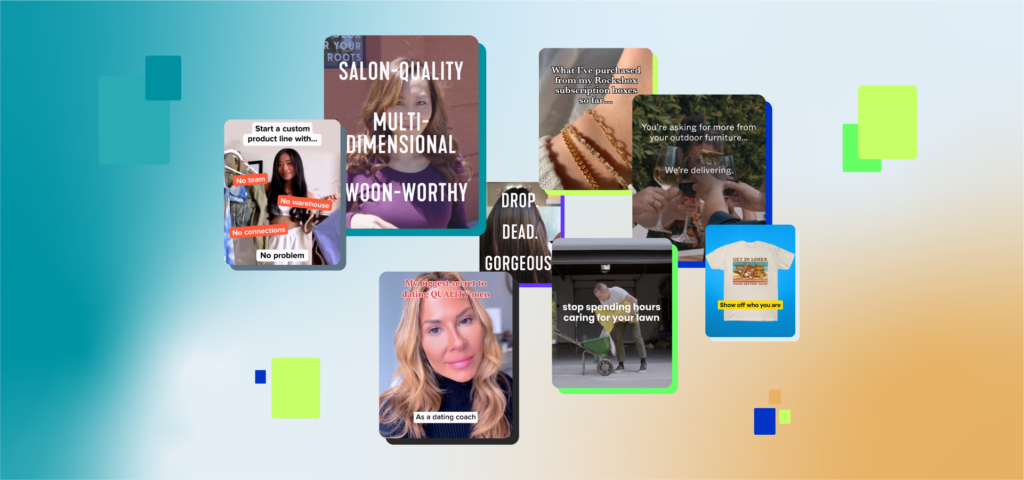
Simply put, CTAs drive conversions.
When you end a video ad with a CTA, you’re prompting your audience to make a purchase, learn more about a product, or sign up for a service.
In other words, you convinced your target audience to watch the ad with an attention-grabbing hook and showed them the important details, frame-by-frame, by using a proven video ad template. Your CTA tells them what to do next.
Once your audience is inspired to take action, you can boost your conversion rate by having your CTA lead to a landing page tailored to your audience’s ad experience.
Yet, certain types of CTAs aren’t equally effective on all social platforms. In fact, on some platforms, a CTA done wrong can appear out of place for users.
Take TikTok, for instance.
Did you know TikTok ads that blend into the native content of the platform perform much better than those with a prominent CTA?
That’s because TikTok audiences are likely to click away from ads that feel like ads. Users quickly spot and move on from ads that go heavy on branding and a more traditional, overt ad-style presentation.
In these cases, it’s better to let users find their way to the product organically by matching the style of the platform. For instance, you can convert on TikTok by adopting a single-influencer UGC style, avoiding ending with brand cards and overt CTAs, and leaning into native elements of TikTok in your ads.
CTAs That Convert
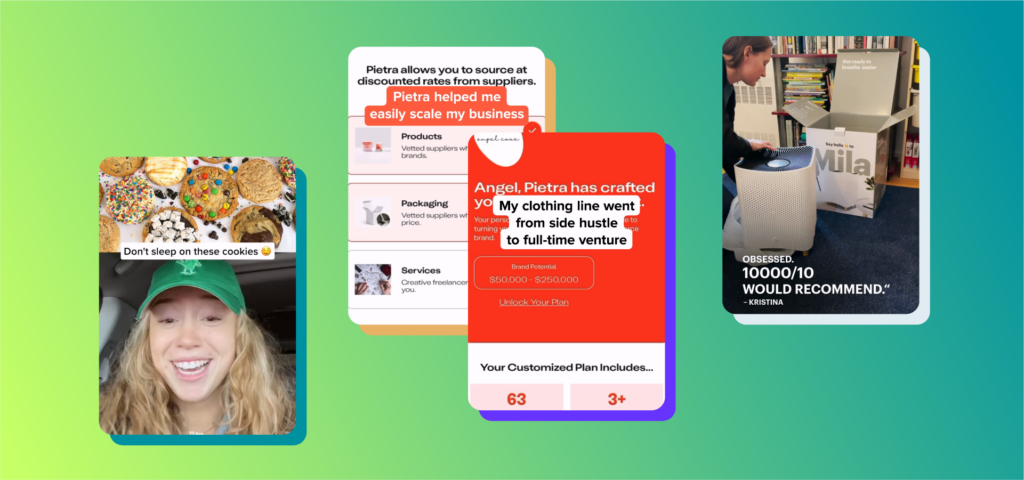
Regardless of the social platform where you’re running your ad, a CTA should feel organic to the user and native to the social platform. That’s where we come in.
Check out these 25 examples of CTAs Primer has developed that are proven to convert.
Native Style
As we touched on above, users on platforms like TikTok are fast to click away from ads that feel overproduced and non-native. On the flip side, a native-style ad mimics the elements used on a specific platform, like text and colors, trending sounds and music, and a video format consistent with other users who post on the platform.
- No CTA included (a purely native-style ad).
- End with a search bar. Start your ad with a user searching Google and end with a CTA that is your search term.
Search Bar Example:
UGC Style
A UGC content format is a way to personalize your ads by using creators and UGC ad templates to give them an organic feel. Continue that user voice in the CTA. Test including the CTA both in text on the screen and in the voiceover. We find that using just in the voiceover is powerful, like in the example below, because it feels more like a user’s unique point of view.
- Give [brand] a try. (Great in a customer or creator’s voice: “Definitely, give State Bags a try!”)
- Go check out [brand]. (Another good one for a creator’s voice)
- Don’t sleep on [product]. Order today!
- Don’t waste any more time. Give it a try.
UGC Example:
“Get Started!”
Inspire your audience to act by showing them how simple it is to take the first step with your brand.
- Get started with [brand].
- Get started for [price].
- Get started online.
Problem/Solution Oriented
Highlight a problem or problems your audience might have, or offer solutions to problems they didn’t know existed.
- Fix your [problem].
- Are you ready to let [brand] [solve problem] for you?
- Discover your [solution] today. (Example: Discover your custom lawn plan today.)
- Upgrade your [problem area] today. (Example: Upgrade your outdoor space today.)
- Kickstart [solution] with [brand] today. (Example: Kickstart their reading progress with Ello today.)
- Order [product] today and get [benefit]. (Example: Order a Zen One bundle today and get better sleep in 1-3 nights.)
Fix your [problem] Example:
Promotional/Freebie
Everyone loves to save money on a good deal. Offer your audience a promotion that’s free or discounted, such as a membership, shipping, or money off their purchase.
- Sign up for free today.
- Free shipping (use the CTA to communicate a special offer).
- Get your free [offer/analysis/quiz results].
- Give it a try for just [price].
Free Shipping Example:
Product-focused
Using product-focused ad templates and content is a great way to build up to a CTA that drives home the message about your product.
- Find your perfect [product/attribute].
- Discover [product] just for you.
- Start searching. (This one is great for marketplaces or stores with multiple SKUs where you’re communicating to a wide variety of consumers.)
- Sign up for your first [product] today. (This CTA is effective for subscription brands.)
- Find yours today. (Note that this CTA should be used in voiceover and not in the text on the screen.)
- Say 👋 to [brand].
Say Hi to [brand] Example:
Beyond Ad Templates: How Primer Helps Drive Growth
Using these CTAs in your ads can help drive conversions and boost growth, and they can be easily incorporated into one of Primer’s tested and proven video ad templates.
Remember, hypergrowth marketing is all about using what you already know works to build winning ads!
Beyond offering a range of ad templates to craft high-converting social ads, Primer gives you the tools to keep pace in a rapidly evolving marketing landscape. We help our partners develop top-performing ads and scale them effectively through rapid, high-volume testing of your videos and social ads. This gives you the insights to tap into current trends, iterate top-performing ad content, and maximize your growth.
Primer handles the process for you, including
- Creative strategy
- Design
- Production
- Reporting
- Media buying
Schedule a free consultation with Primer to learn how creative testing can help you create successful video ads with CTAs that will take your brand’s growth to the next level.
User-generated content brings products to life in a far more personalized way than traditional ads. Increasingly, your customer’s experience with products comes through their smartphone screen. By hiring professional UGC creators and using UGC templates, you can maximize the value of customer-created content and harness the power of authentically representing the user experience.
But “authentic” is the operative word—and it’s where others can fall short if they’re not intentional about hiring the best content creator for their brand.
Follow these essential tips to maximize your UGC by hiring the perfect pro to create content your audience can’t resist.
Why are UGC templates successful?
Brands are embracing user-generated content (UGC) worldwide, but only some use it effectively. While anyone can use popular UGC ad templates, professional content creators have the experience and creativity to make your content stand out—driving engagement and conversion rates.
The pioneering “user” in UGC
Before UGC rose in popularity with marketing teams, users posted and shared organically created content. The posts were based on real-life experiences with a product or service and geared towards their followers—and potential customers.
Embracing the opportunity to build a community around their products and services, companies seized the opportunity to engage directly with their customers.
Brands repost reviews, feedback, and other user-generated content on their social channels to positively influence engagement metrics. According to one survey, 77% of respondents are more likely to purchase products from brands that use UGC.
UGC in ad campaigns
To traditional marketers, UGC ads seem counterintuitive. The brand takes a back seat, the production value is intentionally low, and they’re giving up some creative control.
A professional creator understands the fundamental advantage of user-generated content. UGC minimizes consumers’ distrust of conventional advertising by engaging directly with brands’ customer base from the consumer point-of-view.
And most importantly, content creators know how to do it authentically—with eye-catching content that subtly communicates your call to action before your audience realizes they’re watching an ad.
UGC creators vs. influencers

Although influencers create content, there are significant differences between UGC creators and influencers. Know the difference so you can hire the right content creator to represent your brand.
Influencers
Brands engage influencers as product ambassadors for access to their follower base and clout as microcelebrities. It is tempting to reach out to influencers because of their large followings, but it’s important to note that their audience may not be relevant to yours. Misaligned or unrelated content could be interpreted by their audience as outright advertising, which isn’t the intention of well-made UGC, or you could end up paying for an audience that is not likely to convert.
Content creators
Brands hire UGC creators for their creativity, ability to capture the brand’s voice, and connection with a target audience. They don’t need a large following since they do not typically share UGC content on their social channels. Social platforms like TikTok and Instagram Reels have popularized UGC templates for both ads and organic posts alike. With content creators, brands can leverage those UGC templates to create ads that feel more native to the social feed.
Content niches
At their core, UGC creators and influencers are content creators experienced in crafting a message that resonates with an audience within niches. Partnering with creators who can speak directly to your audience, whose audience matches your ideal customer, and who represents that ideal customer maximizes your brand’s messaging.
Brands are no longer limited to marketing strategies that rely on public figures and celebrities with large audiences. As a result, content creators give brands a voice that is relatable and accessible.
Consider your audience
The more your creator fits the persona of your target audience, the more successful your campaigns will be. They will be able to capture your customers’ attention, keep them interested, and motivate them to buy more effectively if they can identify with your audience—their lifestyles, preferences, challenges, and spending habits.
Hiring and working with freelance UGC creators
It’s not one size fits all. Choosing a professional who understands your brand can make or break your UGC marketing strategy, but you may not know where to start, what to look for in a creator, or how to tell if your UGC templates are effective.
How do you find and hire a content creator tailored to your brand and target audience? And how do you keep your project on track once you hire one?
TikTok Creator Marketplace
TikTok is the mothership for UGC creator content. There is an endless supply of talented creators ready to take on your project—and TikTok made it easier than ever.
Discover hundreds of professional content creators on the TikTok Creator Marketplace by applying filters based on the type of creator you need, your brand’s goals, your target audience, and other relevant requirements.
Tip: Searching #UGCcreator tags on TikTok and Instagram is a great way to surf professional UGC creators’ content to see if they’re the right fit for you.
Fiverr & Upwork
Popular freelancing platforms, like Fiverr and Upwork, allow businesses to browse through the catalog of talented UGC creators or post an ad for their campaigns. Creators have their rates and reviews in their profiles, helping you stay on budget while searching for your perfect creator.
Connect with a creator
Investing in a content creator to convert your product or services into credible endorsements and content that feels native to the platform requires some prep work.
It’s important to communicate your brand’s goals. Define your marketing goals and sales strategies ahead of time. Your perfect content creator can apply your UGC templates to make the biggest impact.
If you think you’ve found the right creator, talk to them about your campaign. They need to know:
-
- About your company: your target audience and UGC goals
- Campaign name + details
- Campaign budget
- Their point of contact
Impactful UGC templates
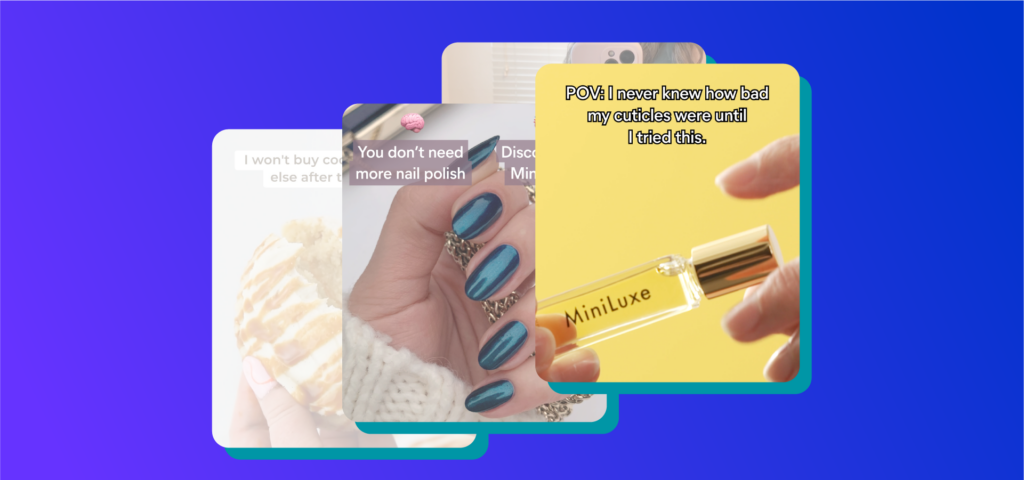
Professionally made UGC blends advertisements with organic user content, but it’s only effective if customers believe in its authenticity. Viewers won’t stick around if they feel tricked into watching a sales pitch. The pros know how and when to use different UGC templates depending on your goals, your audience, and your product. And by passing off these ads as native social media content, popular UGC templates are integrating creator-produced UGC into ads that convert.
Common freelance UGC creator challenges:
Delayed response times
Independent contractors might not have availability to respond to your inquiry immediately or have room on their schedule to spearhead your campaign due to other client commitments. When seeking out creators, ask for their availability right away and make sure to factor in production times (see below).
Surprise fees
You never want to be caught with surprise fees or upcharges. Start by confirming the fee structure against their freelancer profiles before moving forward to avoid inaccurate rate estimations.
Production delays
Make sure you factor in the time it will take to ship the product and have it arrive in the creator’s hands. You should also consider the time it will take to film the content, deliver the footage, and then edit time on your end and apply your UGC templates.
Getting ghosted by creators
Let’s face it, getting ghosted by creators, or slow response time from creators, is not as unusual as you’d hope. It can take a lot of research and reaching out to find a reliable content creator who is professional and responsive. Try to factor in the time it will take upfront to find the right match and get the responses you need to confirm it.
Let them work their magic
Remember, making heavily scripted notes can hinder your creator’s creative process. Add these points to your UGC brief to set your campaign up for success.
- UGC brief
- Required shot list
- Product approach: selling points and important details to mention
- Brand do’s and don’ts
- What the creator should not to say (e.g. any legal limitations, competitors, etc)
- Ask the creator not to add copy to the videos—makes the footage more versatile and avoids future image cropping issues
- High-level creative concepts
- Trending sounds
- UGC template preferences, like “How to” videos, etc.
- Layout ideas
- Authenticity is essential—audiences won’t appreciate blatant advertising. Keep the content organic and natural. The best UGC campaigns are natural and unpolished, so avoid overdirecting.
You’ll get more ad material for your money if you don’t expect—or ask— for a completely finished ad from your UGC creator. Instead, direct your creator to record a few different hooks and show a few different sets. You can edit the raw material yourself and end up with more than one ad from the same material.
Finally, if you like the content creator’s work, hire them again!
Consider the done-for-you UGC route
Alternatively, you can leave the entire process to the pros at Primer. By offloading the UGC creator-hiring process to a marketing company that excels in social advertising, you’ll save yourself the time, staffing, and hassle of tracking down and project managing a freelancer.
Primer-led prep work
Primer builds your ideal customer persona for you, eliminating the guesswork from identifying your target audience.
Simplify the search
With Primer, your brand is connected to the perfect content creators based on your audience profile through their extensive network of highly qualified, trusted specialists. Primer allows you to rank a list of 5-10 verified creators that match your brand.
Primer-led ad creation
Using the content creator’s video footage, Primer creates multiple iterations of your ad across a variety of platforms. Building multiple ads allows you to test them against each other and discover a winner among them.
Simplify your UGC creator search
Whether you DIY or let Primer handle the heavy lifting, you’re on your way to maximizing your UGC content and sharing content your audience will love.
Did you know that mobile Facebook users spend an average of just 1.7 seconds engaging with a piece of content? Meanwhile, desktop users spend a mere 2.5 seconds before moving on.
By the time you wrap your head around those numbers, Facebook’s billions of users have already scrolled on!
Why is this important?
The fact is that in today’s social media landscape, video ads are fast becoming a dominant form of advertising. In fact, many DTC brands have shifted annual spend in order to invest in more video advertising due to the benefits of doing so.
Video ad spending is projected to react $210.20 billion this year, with an annual growth rate of 10.97% from 2023 to 2027. The growing popularity of video advertising versus other ad formats with users justifies this shift in ad spend. Google data shows nearly half of internet users sought an online video about a product or service they were interested in before visiting a store.
When thinking about how to create successful video ads for social platforms like Facebook, Instagram, TikTok, and Snapchat, it’s clear that the most effective ads must grab a user’s attention from the very first second.
After testing thousands of ads across multiple paid social channels, Primer found that ads that got the highest engagement contained elements such as:
- Integration of native elements of the platforms they are using
- Tested and proven ad themes—or “big ideas”
- An attention-grabbing hook
- A frame-by-frame breakdown based on a tested formula
- A clear CTA to end the video
First and foremost, writing a winning video ad starts with a well-developed video creative brief, with a full video outline and all creative elements. Plus, a standardized creative brief template can be critical for creative teams, providing a roadmap to produce a high volume of ads and effectively scaling top-performing content.
Yet, there are many considerations when fleshing out what works and what doesn’t across multiple social channels and audiences. Here are our top tips for writing a successful video ad script.
Start with a Video Creative Brief Made for Video Ads
A successful video ad script starts with a finely tuned video creative brief template, outlining your video in full detail, frame by frame.
Starting with a creative brief template designed specifically for video ads provides several benefits. First, it helps you structure your copy and visuals in a format that makes it easy for both you and the video editor to map out or storyboard your video. This structure also makes it easy to come back later and iterate on this video ad once you have found wins. This allows your creative team to align and stay on target.
One of the top considerations when formulating a video creative brief is determining which channels are best for placing the ad.
For instance, ads made specifically for TikTok also perform well on Instagram, though the reverse is not always true.
Start with a big idea brief to test a brand-new concept, such as a theme, audience, value proposition, product, or benefit.
Then scale top-performing ads with iteration briefs. Once you find a winning ad from your big idea, then you develop several iterations, or variations, of specific ad elements, allowing you to both scale the win and also hone in on the specific components that your customers are responding to.
Developing these briefs will allow you to write a unique video ad script that you can transform into engaging content.
Select a Theme That Has Proven to Convert
At Primer, we’re constantly testing new ad formats, themes and messages. Through this testing, we have honed in on a handful of high-converting themes that we know work every time.
One of those is what we like to call “How It Works.”
This theme drives conversions every time because it breaks down how a product works to help solve the problem of your target customer.
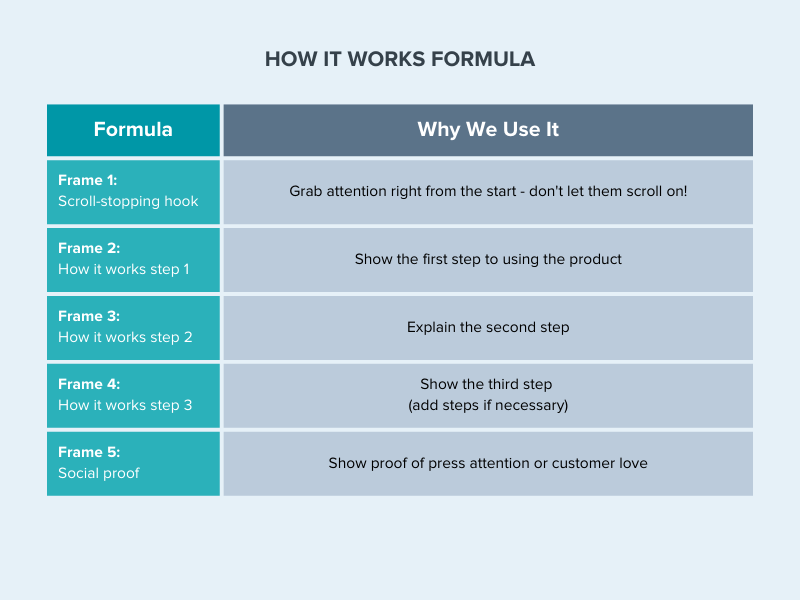
Take, for instance, a video ad by lawn care company Sunday, which uses the How It Works theme to great effect.
Here’s another look at the theme applied to this Sunday ad.
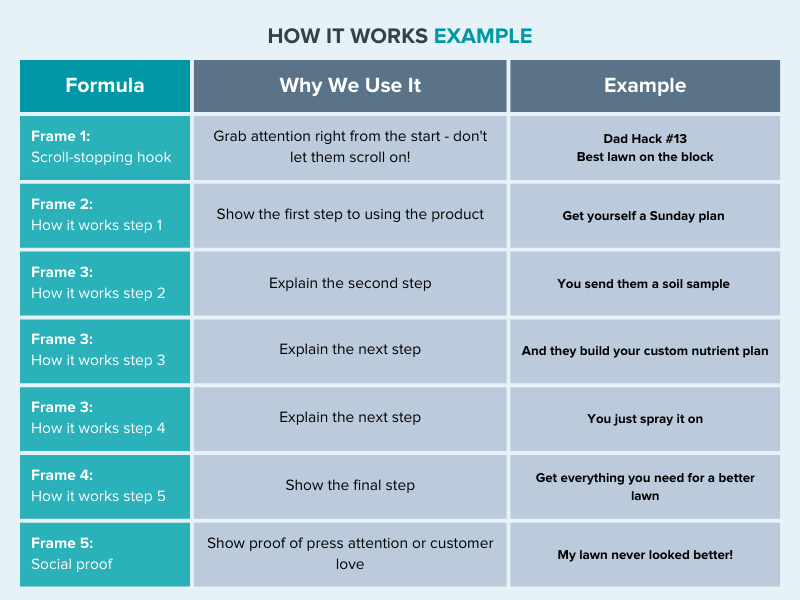
Now let’s take a closer look at what your video ad script should include.
Break Down Your Video Into Sections
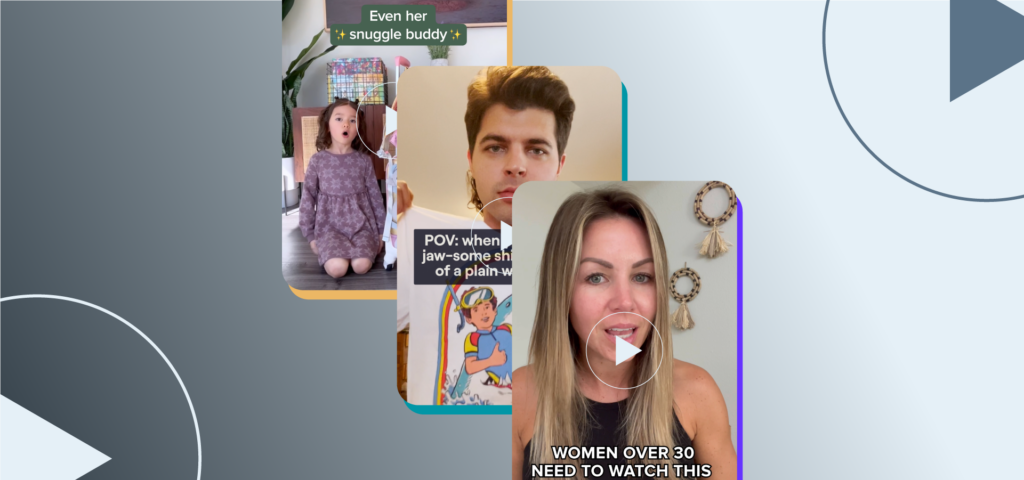
Just like the example illustrated above, each section of your script should be outlined in your video ad brief.
Keep in mind that the intro—or the first 3 seconds of your video—needs to hook the user and halt their scrolling. Otherwise, they’ve already moved on, and you’ve lost a potential conversion.
This means your video intro should have a strong hook and movement (no still images)!
Some examples of effective hooks include:
- Price-focused: “Need affordable [product type]? Watch this!”
- Informative: “Let me show you my biggest life hack for X.”
- Versus the Alternative: “I wanted to stop doing X, so I tried this instead.”
Check out all 101 of our video hooks to stop users from scrolling and get more ad clicks.
Next, break it down into frames at each transition moment in the video. Note that you should keep the copy very short for each section, whether this is verbal or text—about 2-3 words per screen or frame.
Content Beyond the Template
To transition from a template to a fully-developed video ad script, you need to determine the most essential messaging for your audience and apply that to the ad template. Key components to include in your ad messaging includes:
- Social or press proof: This is a way to showcase the recommendations of others who’ve reviewed your product or service. It is essentially a form of “word of mouth,” often presented as UGC, that increases your credibility and trust with a specific audience.
- Key benefits to the customer: The video’s messaging should focus on your customer and how your service or product helps them, emphasizing the benefits provided rather than just the features themselves.
Beyond these key elements, you can develop the specific content of your video ad by using any of Primer’s proven-to-convert video ad templates.
Here are a few examples.
User-Generated Content (UGC)
When trying to capture the native style of a paid social channel like TikTok, you can’t do better than a UGC style approach. This approach will feel like an organic post to the platform while highlighting how your product or service solves a consumer’s problems.
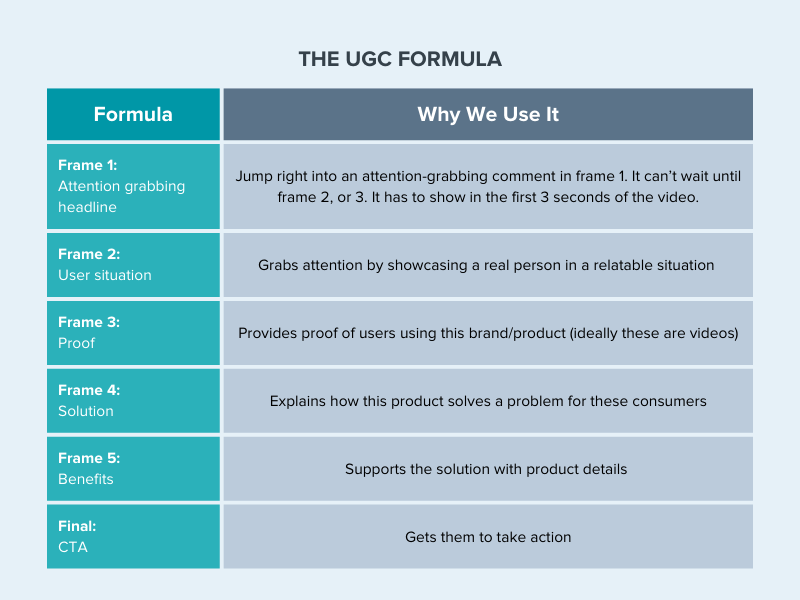
Buyer Decision Questions (BDQ)
Buyer decision questions are questions your highest-converting buyer personas are likely to ask before purchasing a product. For instance, they might have questions about price, quality availability, and how it works. This video ad template anticipates and answers those questions.
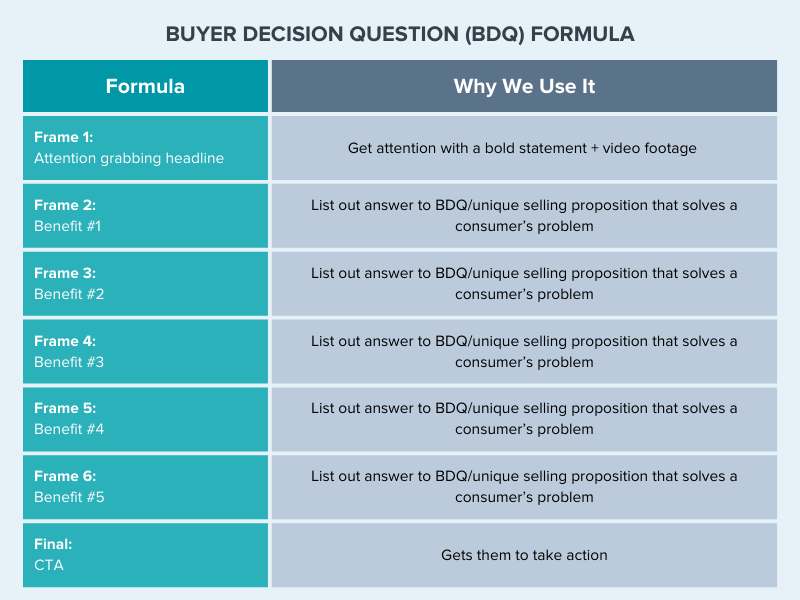
Press + Testimonials
This approach uses press quotes and consumer testimonials to demonstrate social proof that the product has been proven to work and is preferred by consumers. You can use customer voiceovers honestly reviewing the product to show UGC.
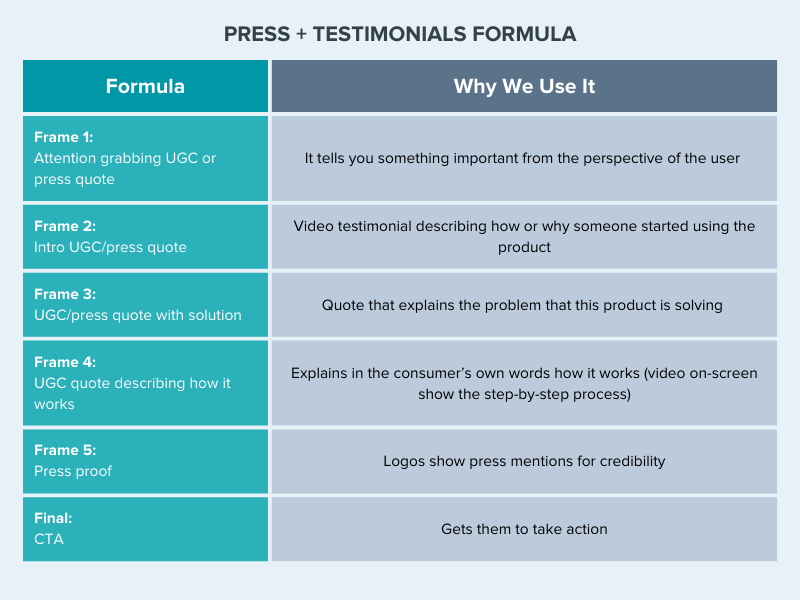
These are a few of our templates you can use to structure and iterate top-performing video ads. Though, regardless of which you choose, one thing all successful video ads share in common is that they direct the viewer to take action.
End on an Action
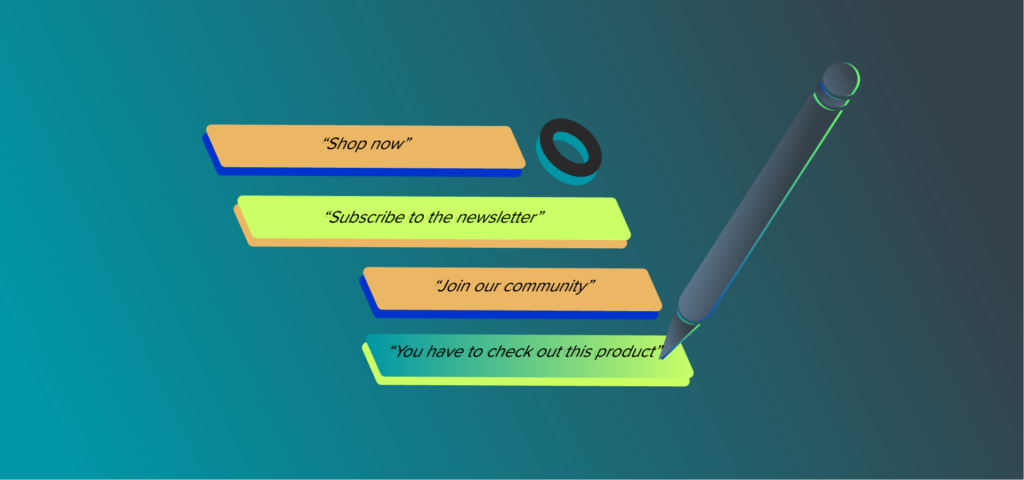
Okay, so someone watched your ad. They engaged. They didn’t scroll. Now what?
All ad content relies on a strong call to action (CTA) at the end of the message, something to drive people to take a certain action, like setting up a free consultation, subscribing to a newsletter, or downloading a deliverable—a next step that moves them further down the buyer’s journey.
Your video ad is no different and should give your audience a clear action to perform after watching. How you present your CTA depends on your audience and the specific paid social channel where you’re running the ad.
A few examples include:
- A special offer at the end of the video (e.g. Try for $15)
- A benefit the customer can expect to receive (e.g. Start sleeping better today)
- “You have to check out this product” or “you can find this product at your local [insert store type here]” at the end of a UGC ad.
Bonus Tip
Remember, ads that feel native to the platform are far more likely to get engagement than those that appear generic, highly polished, and focused on brand graphics and presentation. Also, make sure the voice and performer in your video match your brand and that they comea cross as an authentic customer!
Authenticity matters, so don’t be afraid to shoot footage on your phone for your video ad. While you may have concerns about an ad like this fitting within your brand identity, the fact is that ads that mimic native content simply perform better and garner more conversions.
Footage from a cellphone can feel more organic to certain social platforms. Not only that, but phone quality has improved drastically over the years. Gone are the days of grainy resolution and choppy framerates. It’s no longer just amateurs using phones to produce video content. Even music superstars like Selena Gomez have used devices like the iPhone to shoot professional music videos.
How Primer Can Help
Growth marketing is a high-stakes, high-reward proposition. Rapid, high-volume testing of your videos and social ads enables you to track the most effective trends, scale your success, and iterate top-performing ad content.
Primer works to help our partners develop winning ads and scale by handling the process for you, including creative strategy, design, production, reporting, and media buying.
If you need high-quality ad creative with a rapid turnaround, our online platform Primer On-Demand gives you access to videos, images, and landing pages with a proven track record of driving conversions.
Schedule a free consultation with Primer to learn how creative testing can help you script successful video ads

